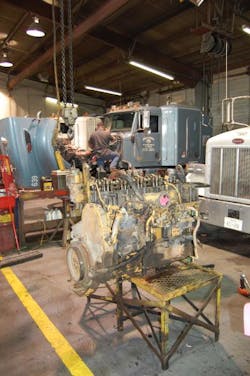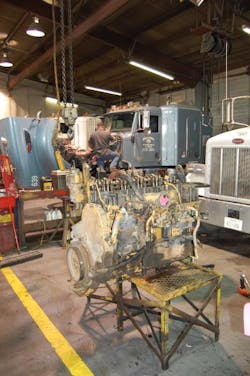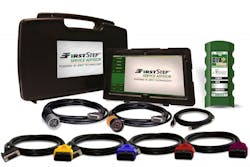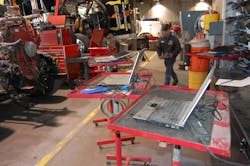One line of attack that’s being pursued is the effort to create “all-in-one” diagnostic tools, with the end result exemplified by Noregon’s JPRO software product and the Cojali Jaltest system, just to name a few.
Another effort focuses on maintenance protocols themselves, something that Norgeon is also taking a stab at with its new First Step Service Advisor unveiled this week at the 2014 Technology & Maintenance Council annual meeting in Nashville, TN.
I talked to Greg Reimmuth, Noregon’s senior VP of sales and marketing, about this at the show and he told me this new service is all about untangling what he calls the “mismatch” of information that occurs on both the front- and back-end of truck maintenance work.
“For example, we get fixation on these indicator lamps; these signals that something’s wrong,” Reimmuth explained. “But what may really be happening is that the battery isn’t providing enough voltage. And low voltage can play havoc with all the electronic-based systems on today’s trucks.”
He believes the trick to all this is two-fold: first, to set in place automatic procedures on the front end to help technicians any “simple” problems while confirming major issues are in truth the “real thing,” while on the back end easily and quickly producing detailed documentation about the entire repair to help build a solid truck maintenance history.
Better diagnostics and documentation should also aid in speeding up the flow of maintenance work through repair shops, regardless of whether they are operated by fleets or dealers.
“These are inherent problems in the shop environment no matter who runs it,” Reimmuth stressed. “Minor problems can become major pain points by creating work backlogs. And ‘bad’ processes can create ‘bad’ behavior in terms of how to go about making repairs as well.”This isn’t just conjecture on Noregon’s part, either, as the company conducted series of in-shop studies over the past two years and discerned that 57% of all trucks that were repaired and sent back into service had significant, undiagnosed fault codes or vehicle issues that were not detected using traditional diagnostic and repair processes.
Norgeon’s research also found that only around 15% of all non-warranty repairs – note that “non-warranty” designation – required the use of OEM software for diagnosis.
“The large majority are fixed with the diagnostic trouble linked to troubleshooting and repair information, parts and a wrench,” Reimmuth said.
The solution from Noregon’s perspective is to move away from what the firm calls “serial diagnostic routines” and instead take a “total vehicle health” approach.
From where Reimmuth sits, that “total health” approach vastly reduces the chance of root cause misdiagnosis.
“One common example is when a reported problem with engine or transmission performance actually gets identified as an issue with a related body or chassis controller,” he told me. “Remember: we’ve got multiple computers on today’s trucks, not only commuting information to the driver but exchanging data between one another. In many cases it’s going to require a ‘total vehicle scan’ to identify the root causes of problems.”
Reimmuth also noted that as there are over 38,000 fault codes on a typical truck today, the chances are just legion for going off in the wrong direction right from the get-go. That’s why he thinks a three-step “total vehicle health” approach is better: a process that begins with an initial diagnostic “triage,” followed by a more detailed diagnosis and repair protocol that confirms the problem and fixes it.Noregon’s First Step Service Advisor comes into play during that critical “triage” stage; a tablet-based diagnostic system that allows service writers and/or shop foreman the ability to connect to a truck and, in less than a minute, receive a complete vehicle health report on the vehicle’s electronically-controlled components – the engine, transmission, anti-lock brake system (ABS), and body controllers.
At the same time, First step is designed to automatically document vehicle health information to avoiding data manual entry during the repair estimation process, providing both technicians and customers with documentation of vehicle health information before the repair even begins.
Reimmuth said that “big picture” look should help technicians make the correct repair by clearly identifying the root cause the first time around, which should also help boost technician efficiency.
Again, trying to make the truck maintenance and repair process faster, smoother, and more accurate, with more detailed histories of the work performed being spat out at the back end (along with a vehicle ready to get back into revenue-generating service) certainly isn’t a new endeavor.
I certainly expect to see more such solutions to be proffered from dealers, OEMs, and third parties alike in the months and years ahead (in addition to what’s already out there, of course.) For taking care of today’s high-tech trucks is only going to get more and more complicated in the future.



